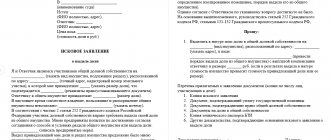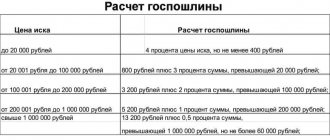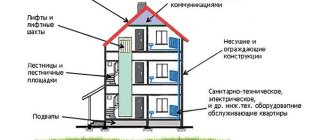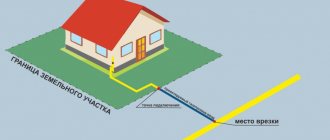Home » Housing disputes » Allocation of a share in kind from the common property of a private house
6
Shared ownership of a private residential building presupposes the peaceful coexistence of all participants in shared ownership, as well as members of their families. But this does not always work out. If the co-owners have any disagreements, then the conflicts may eventually develop into an acute phase, when the division of the house becomes inevitable.
In this case, only the actual division of the household into two or more separate parts will help.
In what cases is the allocation of a share impossible?
Any private household is a separate building on a single foundation, with one roof, common walls, so separating one part of the house without compromising the integrity of the entire structure is not always possible.
There are situations when allocating part of a house in kind is physically impossible, for example:
- Previously, the house was rebuilt, but the redevelopment was not legalized. In other words, the alteration was not agreed upon with the BTI, and accordingly, information about the layout of the house is distorted.
- Worn-out building. A dilapidated, old house is unlikely to withstand any significant redevelopment; it may simply collapse during the remodeling process.
- Any allocation of a share in kind affects the property interests of other co-owners. This clause is observed especially strictly if the interests of minor children, disabled people, or low-income citizens are affected.
In cases where the physical allocation of a share is impossible, the resolution of the dispute, in accordance with clause 4 of Art. 252 of the Civil Code of the Russian Federation, occurs by paying one of the parties to the conflict monetary compensation for its share of property to the other.
In this case, the physical share of the owner who wished to allocate his share is preserved, the initiator receives monetary compensation, but loses the right to his part of the home ownership.
Nuances of judicial practice
To argue a position in court, the plaintiff must provide evidence of his case. As judicial practice on the allocation of a share of a house in kind shows, examinations are often appointed to help determine whether the property can be divided.
When making a decision, the court takes into account:
- suitability of the house for use after allocation of the share;
- rights and interests of third parties;
- compliance of the actual share with legal norms.
Sometimes an independent property appraisal is necessary. These measures are necessary to accurately determine the value of the part of the object that belongs to the citizen.
What does allocating a share in kind give?
Any residential property can belong to one or several owners at the same time. This type of home ownership is considered common property. In this case, all co-owners have equal rights to use the property, but none of the owners has the right to dispose of it independently, without the participation of all other co-owners.
Hence the desire of many co-owners of residential buildings to allocate their part of home ownership in kind. There are several reasons, including the co-owner who allocated his part of the property has the right:
- Use it as you wish. He can: sell his share;
- pass on by inheritance;
- give;
- leave as collateral;
- remodel or improve.
Thus, the physical allocation of a share completely separates one of the co-owners from the other owners of the house and makes it possible to use their part independently of the others. In this case, the remaining part of the house remains in the shared ownership of the remaining homeowners, without losing the status of shared ownership.
Disposal of common shared property
Shared ownership implies that several citizens have rights to property. Common property may arise under the following conditions:
- make a deal;
- receiving an inheritance;
- creation of a farm;
- joint construction of a house and so on.
Depending on the size of the share and the type of property, each owner covers the costs of its maintenance and can receive income.
Although a definition of the parts belonging to the participants is provided, shareholders can use the shares at their own discretion, but dispose of the property by joint consent. If this cannot be done, they have the right to demand monetary compensation from other participants. If disputes arise, you must go to court.
The right of common shared ownership is terminated due to the division of property or the separation of a part from the property. When common property is divided, it ceases for all participants. In a situation with allocation - for one person.
The procedure for allocating a share in a house by agreement
If all co-owners are interested in allocating shares and there are no legislative obstacles, then the division procedure is quite simple. But a verbal agreement alone is not enough; you will have to enter into a written agreement, if necessary, negotiate monetary compensation; at the last stage, you will also need to contact Rosreestr to change the entries in the Unified State Register.
Where to contact
During the extrajudicial procedure for allocating part of the home ownership, it will be necessary to contact several government authorities, namely:
- you will have to contact Rosreestr or BTI in order to determine whether it is in principle possible to physically allocate part of the house;
- the value of the share is assessed by any appraisal company that operates in the SRO system;
- to register changes, you will need to contact Rosreestr again (directly, or through the MFC);
- a new document of ownership is also issued by Rosreestr;
- the agreement on the allocation of a share in kind is drawn up and certified by a notary office.
Particular attention will need to be paid to the technical expertise of house construction. A BTI specialist must answer the following set of questions:
- Is it possible to physically separate part of the house into a separate household, independent of others.
- Does the ownership document provide for the allocation of one of the shares? In other words, ownership of the house is joint or shared.
- Is there a need to refurbish the living space?
- What part of the total area of the property is occupied by non-residential premises?
- How much will it cost to lay new communications and carry out other redevelopment.
- The total cost of all real estate (including all buildings and land).
- If payment in kind is not possible, what amount of money should be paid as compensation.
- General deterioration of housing construction.
In addition, a qualified specialist will determine whether any redevelopment of the building was carried out, and if so, how legal it was and how the reconstruction work affected the strength of the structure.
Algorithm of actions
In order for the allocation of a share in kind to occur without unnecessary delays and excesses, it is necessary to follow a certain chain of sequential actions:
Decide on the actual allocation of part of the house and land.
Unlike residential premises in an apartment building, a detached household allows you to allocate a separate separate part of the residential premises and a residential area adjacent to this part of the house. That is why, unlike the division of apartments, the payment of monetary compensation occurs much less frequently.
In order to determine whether the actual redevelopment of the property is possible, the initiator of the allocation must invite a cadastral engineer who will inspect the property and draw up an inspection report in which he will indicate whether the redevelopment will violate the integrity of the building.
Then the co-owners obtain permission for redevelopment from the local municipality and determine the initiator's share in the equivalent of the allocated residential space.
Get technical plan
The co-owners enter into an agreement with the BTI for the provision of services for drawing up the document, and an employee of the institution draws up a new technical plan on paper and electronic media. According to Art. 24 Federal Law No. 218 of July 13, 2015, the electronic form must have a reinforced seal.
Enter into a voluntary agreement
Oral consent to the allocation of a share must be formalized in a written agreement of all co-owners of the property, which must be certified by a notary office.
Important. The notary personally draws up the document, the co-owners can only make some recommendations on drawing up the agreement, clarify the details and check the relevance of the information included in the document.
Sample agreement on the allocation of a share in kind in common shared ownership
Registering changes
All changes regarding the allocation of shares are registered in Rosreestr. You can either visit this authority yourself or submit documents to the MFC. Changes will be made to a single database, and co-owners will receive new entries from the Unified State Register of Real Estate.
Example
Brothers Pavel and Nikita Ivanov lived in a large house with an area of 200 square meters. meters, inherited from their parents. Over time, both brothers married, each had children, and both families continued to live in the same house, which belonged to the brothers in equal shares.
Five years later, the brothers’ spouses felt a little cramped in the same kitchen, and quarrels and showdowns began, in which Pavel and Nikolai were drawn into. The brothers decided not to aggravate the situation and divided the house in half, giving each of them their share.
The brothers turned to a cadastral engineer, who determined that:
- The area of one share of a residential building is 100 square meters. meters;
- the technical condition of the building makes it possible to redevelop it, equip a separate entrance and connect communications to the second half of the house;
- There were no illegal redevelopments in the house.
Having received the engineer’s opinion, the brothers drew up a voluntary agreement to allocate Nikita’s share and certified it at a notary’s office.
Together, the brothers designated the location of rooms and utility rooms for each family, equipped a separate entrance, installed communications, and erected a permanent partition between separate living spaces. Thus, each of the brothers became the owner of a separate living space.
Documentation
To register the changes made, you will need to submit a certain package of documents to Rosreestr, namely:
- Personal documents: passports of all co-owners, or birth certificates if the shareholders are minors;
- several applications (based on the number of co-owners), including an application for registration of a share in kind for the initiator of the allocation and a petition for amendments to the register from the remaining co-owners.
- technical plan;
Based on the applications, each of the owners will receive a new extract from the Unified State Register, which will become the basis for securing ownership of the allocated share, as well as the remaining parts of the house.
Deadlines
The allocation of a share by voluntary agreement will take much less time than a court resolution of the dispute.
- Verbal agreements and the subsequent drawing up of a document on the allocation of part of the house can take place within a few days.
- It may take from two weeks to two months to prepare a new technical plan and cadastral documents, depending on how busy the cadastral engineers are.
- It will take another two weeks to process the application to Rosreestr.
- The last stage, making changes and preparing new extracts from the Unified State Register, will take 30 days.
Thus, the voluntary allocation of a share will take from two to four months.
Price
Of course, there will be expenses.
- Drawing up an agreement by a notary will cost from 3 thousand rubles.
- Technical work on printing and checking the document will cost from 1 to 2 thousand rubles.
- Certification of a document at a notary office costs 500 rubles.
- For drawing up a technical plan, owners will have to pay, depending on the region of residence, from 8 to 20 thousand rubles.
- For registration of changes in Rosreestr, the initiator of the allocation will have to pay 2 thousand rubles, the remaining co-owners will have to pay 350 rubles.
In total, the entire registration of the actual allocation of the share will cost from 14,500 to 28,000 rubles.
Of course, the financial costs don't end there. Redevelopment and reconstruction of the household, installation of new communications, installation of a separate entrance, reconstruction of heating and gas communications - all this will cost considerable money, but as a result, the owner of the share will receive a separate living space.
Example
Sisters Olesya and Alena Nikiforov inherited from their parents a large two-story house outside the city. Each of them received shares equal to 1/2 of a residential building and half of a land plot.
Olesya immediately moved to her parents’ house, and later her second sister settled there with her husband and two children. But the relationship between Olesya and Alena’s husband did not work out right away; moreover, she was constantly disturbed by her young nephews, who did not see the difference between their room and their aunt’s bedroom.
Olesya talked to her sister and her husband and suggested that they divide the house and plot into two halves, separate from each other. It was decided that the family with children would occupy the first floor of the house, and the second sister would move to the second floor. They decided to equip a separate entrance, as well as a kitchen and a bathroom, and decided to spend the costs of decorating the section of the building equally.
After completing all the reconstruction work, the sisters received two new cadastral passports from the BTI. Then they turned to a notary and drew up a voluntary agreement, subsequently all changes were formalized in Rosreestr.
✅ Do I need to register with a notary?
Lawyers are often asked whether an agreement must be registered with a notary? The question is really relevant. More recently, owners could submit a written agreement without a notary stamp. This practice was in effect until 2021. Now the MFC and Rosreestr require that the agreement be approved by a notary (Article 42 of Federal Law No. 218 of July 13, 2015).
Co-owners don’t even have to rack their brains over composing the text. All actions are performed by a notary, from whom you can find a sample document. Naturally, notary services are paid in accordance with the tariff.
Procedure for going to court
It is not always possible to solve the problem amicably, so legal disputes regarding the allocation of a share in kind are not uncommon.
Step-by-step instruction
In order for the allocation of the actual share to occur successfully, a certain algorithm must be followed:
An attempt at pre-trial resolution of the problem
Lawyers recommend trying to solve the problem peacefully. To do this, it is necessary to draw up a written notification to the remaining co-owners proposing a voluntary resolution of the controversial issue. If the co-owners categorically do not agree to give you a share, try to get written refusals from them, or, if this does not work, give them a notice in the presence of two witnesses.
Collection of documents
After an unsuccessful attempt at a peaceful settlement, the initiator of the division will have to start collecting the necessary documentation. To do this, you need to contact the BTI with an application to call a cadastral engineer. If an engineer, when inspecting a property, comes to the conclusion that allotment in kind is possible, he will draw up an appropriate conclusion.
Then you will need to obtain a new technical plan for your share of the property.
Drawing up and filing a claim
It is advisable to hire a competent lawyer to file a claim in court. Next, the plaintiff must submit this statement of claim, along with a package of documents, to the district court.
Participation in court hearings
First, preliminary hearings take place, where the judge gets acquainted with the circumstances of the dispute and invites the parties to enter into a settlement agreement. If the settlement agreement is rejected, the court will schedule the main hearing.
During the preliminary hearing, the judge may request the plaintiff or defendant to submit additional documents regarding the case to the main hearing.
Obtaining a court decision
The court can either side with the plaintiff and satisfy his claims, or refuse to satisfy them. In the first case, the plaintiff receives a court decision in his hands (after it enters into legal force). In the second, he has the right to appeal the court verdict to a higher court.
Registering changes
Occurs in the same order as with the voluntary allocation of a share by agreement.
Statement of claim
Sample statement of claim for allocation of a share in kind
The statement of claim must include the following information:
- Full name and details of the district or city court.
- Personal data of all parties: their full names, addresses, contact details.
- Cost of claim.
- Circumstances of the case: type of property, listing of all co-owners, how the house was acquired, address and technical characteristics of the property.
- Information about attempts to pre-trial dispute resolution.
- The plaintiff's position.
- References to those articles of law on the basis of which the plaintiff demands the allocation of a share in kind.
- Claim.
- Numbered list of attached documents.
- Date and signature.
Documentation
The following documents must be attached to the statement of claim:
- Copies of the claim (at least 3 copies).
- Technical passport for the property.
- Legal documents. This could be: a purchase and sale agreement, a gift, a privatization document, papers on inheritance.
- Extract from their Unified State Register.
- Conclusion of a cadastral engineer on the possibility of redevelopment of the house.
- Receipt for payment of state duty.
All documents, except the receipt for payment of the state duty, are submitted to the court in copies.
Deadlines
The minimum period during which court hearings will last is 2 months from the date of filing the statement of claim. But usually the consideration of claims for the allocation of a share lasts from 3 to 6 months, sometimes up to a year.
In the event of a positive court decision, further deadlines correspond to those for the voluntary allocation of shares.
Cost, expenses
The main costs are the payment of state fees when filing a claim. Its cost depends on the price of the claim and ranges from 400 to 60,000 rubles. You can calculate the specific amount according to Table 1.
Table 1. Calculation of the amount of state duty when filing a claim for the allocation of a share in kind
| Cost of the claim, thousand rubles. | Fixed amount | Additional interest on excess amount |
| up to 20 | not less than 400 | 4 |
| 20 — 100 | 800 | 3 |
| 100 — 200 | 3 200 | 2 |
| 200 — 1 000 | 5 200 | 1 |
| over 1,000 | 13 200 | 0,5 |
Arbitrage practice
When summarizing the judicial practice on the allocation of the actual share of a private house, certain conclusions can be drawn that the final decision of the judge will depend on:
- the possibility or impossibility of actually allocating a share;
- technical documentation for the property;
- compliance with sanitary, hygienic and housing standards;
- contractual capacity of the parties.
Example
Astana’s two brothers and sister inherited a residential building in equal shares: 1/3 of a share each. The brothers wanted to use the house as a summer house, but the sister wanted to sell her part because she was going to move to another city. But the brothers were categorically against allocating her share of the inheritance, and they also refused to pay her monetary compensation.
Astanina filed a claim for the allocation of her share in kind to the court.
In court, it turned out that there is no technical possibility of allocating a share in kind, since the condition of the property leaves much to be desired and it may suffer during reconstruction.
Having examined the circumstances of the case, the court made a decision:
- the plaintiff’s demands are satisfied in full;
- oblige the defendants to pay the plaintiff monetary compensation for her share of property equal to the market value of her part;
- The plaintiff's share is divided among the defendants in equal shares.
The allocation of a share in kind depends on many different nuances, which are quite difficult for a person ignorant of jurisprudence to understand. This especially applies to the judicial procedure for resolving a dispute. Therefore, if you need to allocate your share from the common property, then it is advisable, at least at the first stage of drawing up a statement of claim, to seek help from an experienced lawyer.
You can also get a free consultation from the lawyers on our website. It will be enough to call the numbers listed below, or call the lawyer on duty online.
FREE CONSULTATIONS are available for you! If you want to solve exactly your problem, then
:
- describe your situation to a lawyer in an online chat;
- write a question in the form below;
- call Moscow and Moscow region
- call St. Petersburg and region
Save or share the link on social networks
(
1 ratings, average: 5.00 out of 5)
Author of the article
Natalya Fomicheva
Website expert lawyer. 10 years of experience. Inheritance matters. Family disputes. Housing and land law.
Ask a question Author's rating
Articles written
513
- FREE for a lawyer!
Write your question, our lawyer will prepare an answer for FREE and call you back in 5 minutes.
By submitting data you agree to the Consent to PD processing, PD Processing Policy and User Agreement
Useful information on the topic
3
Eviction of a registered person from a municipal (non-privatized) apartment
After living for a long time under a social tenancy agreement, many citizens consider...
4
Eviction of students from the dormitory
Over time, laws change and are supplemented with new relevant articles, of which...
2
How to evict your ex-husband from your apartment
Any divorce process is always accompanied by the division of joint property. If so...
How to find out whether an apartment is privatized or not
The easiest way to understand whether an apartment is privatized or not is to check...
Privatization of a dacha, a house on a dacha plot, a dacha plot
Despite the fact that the right to privatization already exists far away...
How long does it take to privatize an apartment?
Privatization of an apartment is a lengthy procedure consisting of several stages...











